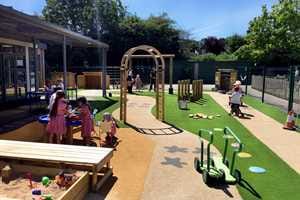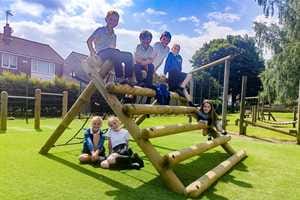
Lesson Ideas and Activities
The Benefits Of Group Work for Your Pupils!
What is Group Work?
Group Work (collaborative) learning allows children to work together during activities or learning tasks in small groups (ideally 3-5 children per group) to allow each child to participate. The children are then encouraged to work on individual activities which contribute to the overall task or work with each other on a shared outcome or goal.
.jpg)
Studies have shown, especially the SPRinG Project (conducted between 2000 and 2005 which looked at improving the effectiveness of pupil group studies in Primary and Secondary classrooms), that working together in small groups will help children to:
- Improve their cognitive development. Children need to realise and compare/contrast their (cognitive) perspectives with others (from Piaget’s 1971 notion of disequilibration and/or Vygotsky’s 1978 internalisation of interpersonal perspectives.
- Understand the difference between child-expert and child-mutual peer relations, which are linked with different types of cognitive-based learning (Doise & Mugny, 1978; Howe et al., 2007; Kruger & Tamanello, 1986; Mercer & Littleton, 2007; Perret-Clermont, 1980.)
- Develop different types of relationships that help with underlying cooperative learning theories (“interdependence theory” Deutsch, 1949 and “contact theory” Allport, 1954)
- Overcome social constraints such as status differences and gender/ethnic preferences (Cohen, 1994; Cohen & De Avila, 1983)
Develop mutuality (as per above) where relationships are formed on reciprocity and sharing enabling children to work together in a positive, supportive, and scaffolded way (Kutnick & Mason, 1998; Webb & Mastergeorge, 2003; Wood & Middleton,1978.)
Group work can be either in:
- Pairs
- Groups or
- Teams of mixed abilities
and encourages competition among the children to aid them to work together in a collaborative manner. However, there is a fine line between competition to encourage the children to work effectively together and being over competitive focusing on winning rather than learning.
Teachers need to assist and support children to practice relationship building and working together in a collaborative manner enabling productive group work. Helping children to:
- Work together
- Learn to compromise
- Resolve petty arguments
- Learn more efficiently
- Behave better
- Solve complex tasks by breaking them down into smaller, manageable steps
- Be accountable for their work
- Receptive to and giving feedback from their peers
Understand their peers’ assets and allow children to have roles and responsibilities that play to their strengths in the groups
Group work is more than just putting children in pairs or sitting them together. Teachers must structure the activities and tasks so that children can gain optimum learning from them and produce effective group work.
The best activities and tasks are those that encourage discussion and interaction between the children. Galton, 1990; Kutnick, 1988; Wentzel, 1991 believe that it is important that children learn to trust and respect one another to enable effective group work.
Whereas Light & Littleton, 1994 state that to trust and communication skills in group work, children also should have the opportunity to jointly plan, organise and evaluate their group work.
Where the teachers should guide from the sides, allowing the children to learn through discussion. Teachers should also arrange their classroom settings to be favourable to group work – including:
- Assembling the physical layout of the classroom
- Providing more occasions for children to work together in groups
- Encouraging daily interpersonal activities
- Promoting groups to work together fluidly with little teacher direction or intervention
Activities and tasks should be put together in a way to encourage positive group work so that:
- Every child contributes during the task
- Every child is participating
- Every child is articulating their thoughts and findings
- Every child benefits from the activity
On average, group work learning has a positive impact on children and is a cost-effective way of raising attainment.
Benefits of Group Study
Group study offers numerous benefits for students, including improved academic performance, enhanced social support, and increased motivation. When students work together in a group, they can share knowledge, ideas, and perspectives, promoting a deeper understanding of the subject matter.
This collaborative approach allows students to tackle complex problems by pooling their different perspectives and skills, leading to more innovative solutions.
Moreover, group study fosters healthy competition, encouraging students to strive for excellence and push each other to achieve their best. This competitive spirit can drive students to work harder and stay focused on their goals. Additionally, group study provides students with access to a wealth of learning resources, including their
Does Group Work Work?
Studies have shown that yes group work actually works especially the SPRinG study in 2000-2005. Proving that the introduction of group work within Primary School settings positively affected attainment/cognitive learning as well as interaction/behaviour.
Some Facts About Group Work FROM SPRinG:
- Primary school children make an additional 5 months progress on average during the academic year from collaborative work.
- The impact of group work learning is lower in literacy (3 months) than mathematics (5 months), whereas science is (10 months).
- Activities with groups of 3-5 children who have a joint goal rather than individual goals, work the best.
- Tasks using digital aids have a lower success rate (3 months overall)
Which Pupils Benefit from Group Work?
High Achievers:
High Achievers (HA) gain valuable learning experiences from group work by developing their leadership skills. They are also encouraged to peer teach within their groups to help others understand. Thus, promoting social and relationship skills. As the saying goes, two heads are better than one, and this is particularly true in group work where collaboration leads to enhanced learning outcomes.
Expected Level Achievers:
Expected Level / Middle Achievers are the children who benefit the most from group work. They can benefit from learning from their HA peers but at the same time can enhance their self-learning by helping lower-attaining children through peer learning.
Children with English as a Foreign Language, who struggle with motivation, or who are socially awkward also benefit hugely from Group Work due to the boosted social interaction.
.png)
Group Work in your Classroom!
As touched on above teachers need to arrange their classroom settings to be favourable to group work, implement routines, procedures, and behavioural expectations of each group.
Teachers must also:
- Give each child a role
- Provide a challenging task for all students to participate in
- Decide upon the size of the groups (preferably 3-5 children in each)
- Give a set time for the work to be completed in
- Encourage student input
- Establish a fair grading process
- Make it clear to the group what their expectations are
Creating a Collaborative Work Space in your Classroom
When designing the layout of your classroom, creating differentiated learning zones to enhance the learning environment, is a great way to meet the varied requirements of your pupils and perfect areas for group work tasks.
By organising your learning spaces into learning zones, your children can connect with diverse learning environments and different types of content. Each learning zone should be designated into a specific area of learning and teaching, which supports a wide range of teaching approaches, communication, and choice for children to learn.
When planning your classroom layout, it's important to know what your classroom needs are. Choose engaging learning zones that utilize the classroom space, and which will enrich your children's learning and group work.
Different Types of Learning Zones:
It's important in Primary classrooms that the following zones are set up:
Literacy (reading, writing, mark making)
An important zone for any classroom this area should encourage children to speak, write, mark make and read individually and in groups. With lots of pens, pencils, paper, notepads, printouts, chalkboards, whiteboards, Eisles, etc at the children's fingertips.
As well as books, printed materials, flashcards, and topic-related vocab. All of these are presented and laid out in a well-labelled, easily accessible environment. A great zone for individual work as well as group work where children can collaborate together to work on a character description or even draw a storyboard together.
Numeracy
A must-zone in any classroom, enabling and enhancing individual and group work learning. This space helps children to improve their special sense, structure and pattern, measurement, time, understand data and make connections and explore the world mathematically as individuals or in groups.
To help there should be lots of resources to promote the children's learning such as number cards, games, counting resources, measuring resources, clocks, whiteboards, easels, paper, printouts, and pencils, etc. All these should be presented and laid out in a well-labelled, easily accessible environment.
.jpg)
Role Play
Role Play is an essential zone for an EYFS environment. It encourages children to explore ideas they have from their own home lives and develop their imaginations. Role play is a fantastic way for children to develop lots of skills such as communication, language, expression, exploration, social, emotional, sharing, and understanding the world.
Role Play zones normally shadow the topic of the term E.G. Doctors Surgery, Vets Surgery, Garden Centre, or Dinosaur Museum… All should provide resources linked to each topic for example for a Vets Surgery there should be animal pictures and labels, stethoscopes, x-ray images, soft toy animals, animal carriers, clipboards, paper and pencils, and animal leaflets.
A perfect zone to set children on a group task learning about how to look after sick animals.
.jpg)
Construction
Children benefit hugely from playing and learning in a Construction zone. The EYFS describes construction in all areas but primarily in the physical, mathematical, and expressive arts and design sections. A Construction area aids children to play, explore, create, actively learn, and use critical thinking to get to the set learning goal. These are all very important to children's learning and success.
A Construction zone should have a wide range of fun materials (sand, building blocks, Lego, egg boxes, mosaic tiles, milk crates, cardboard boxes, twigs, stones, spaghetti, and more) which are stimulating and inviting for children. A perfect area for children to work individually or in groups. Encouraging children's imaginations to grow, increase creativity, improve critical thinking and enable collaborative work!
Small World
Small World zones allow children to dive into role-play with their friends and let their imaginations go wild! It encourages children to explore and express situations and enhances their learning of everyday events.
Small World areas are perfect zones to encourage children to use maths whilst playing. For instance, if the area was a shop, then the children would be counting, adding, subtracting, and positional language. Teachers can use the Small World zone to encourage group work to enhance children learning, social, imaginative, and collaborative skills.
.jpg)
Creative
This zone is formed to help children ignite their ideas and let their creative juices flow. Creating a craft-related zone where games, paints, glitter, glue, materials, magazines, books, recorders, and cameras are stored.
By sharing examples of core concepts for the children to see and to explore children can let their creative juices flow! Allow small groups to work in this zone to draw, list observations, write down questions and work in a collaborative group to create the end goal.
Reading: Reading and Quiet Area
The Reading / Quiet zone is there to help children “Chill Out” but also to encourage reading, learning new words, engage with interesting stories and develop literacy skills. This zone should be a quiet space designated to help children who feel overwhelmed and who need some time out.
Providing time and space to calm their sensory needs and emotions. This zone should have soft furnishings, a well laid out library of books including the terms topic books, some calming fidget toys, and even be created around the term's topic such as a jungle or forest.
Sand and Water
Sand and Water zones are a key resource in EYFS classrooms. Children's personal, social, and emotional learning and development improve when using these resources. A wonderful learning zone to allow children to play on their own or in groups to encourage social and collaborative learning.
From experimenting with different textures and shapes through sand play to measuring and mixing potions with water play. Enriching children's vocabulary, mathematical understanding, problem-solving, creative and fine motor skills.
ICT
ICT zones for EFYS children allow children to experiment and explore as they use ICT to enhance their learning. ICT activities should be fun and exciting as they use their creative, collaborative, and fine motor skills during lessons. An excellent tool for children to work in groups to solve games, code, and work their way around ICT programmes.
Linked Zones
In some cases, zones can be linked for example:
- Small World and Construction Zones: they help extended play and are a fantastic way to incorporate group work into a lesson. For example, the children could be set a task of making up and telling a story in their group. Incorporating the Small World and Construction zones to make the setting of their story. The children can then act out their story using the Small World characters and the scene that has been made out of the construction zone resources. This encourages creativity, personal, social, and emotional skills, sharing, negotiation, and problem-solving skills.
- Creative, Role Play, and Literacy Zones: all interlink as children will be playing in the Role Play area pretending to be Doctors in the Role Play zone, then they will move into the Literacy zone to write their prescriptions and then move to the Creative zone to make a thermometer, medicine, stethoscope etc with natural fluidity through each zone.
It is important that all learning zones in every classroom facilitate children to exchange their ideas with one another. Allowing children to share the responsibility of the activity, communicate, peer learn/teach, and reach the desired outcome as a group.
How Can Pentagon Play Help to Create Learning and Collaborative Work Zones in your Primary School Classroom?
To help facilitate different learning zones in classrooms, where there isn't a lot of space or resources why not use one of Pentagon Play's (Breakout Space Package 1 or 2) all in natural wood effect?
Perfect for tackling minimal classroom storage and offering breakout space/zones all in one! Our Breakout Space Packages are fantastic for enhancing group work activities, individual play, or a quiet zone for all children.
.jpg)
These versatile packages comprise of:
- Low-level storage units which you can arrange in a formation that suits your classroom
- Stack & Sit stools and Benches(for seating with removable cushions and also storage with clear windows so children can see what is stored inside)
- Chalk and whiteboard for drawing, writing, mark making, and more!
The beauty of our Breakout Space Packages is that they support the implementation of breakout spaces or designated zones within a classroom, school corridors, and libraries.
Being able to create free-flowing learning zones (using the units etc provided) will enhance children's learning as they move from zones to zone. The Packages also provide lots of storage space (3 closed units and 3 open display, self-select storage units) between the low-level units and the Sit & Stack stools and Benches.
.jpg)
Children can use the Sit & Stack stools as seating, but they can lift off the removable, comfy cushions, kneel or sit on them and play on the interactive game tops on the stools. Allowing children to explore, sort, and use their imaginations whilst using the Small World diagrams that are on the stool tops E.G. farms and roadways.
The Art Easel can be stacked on top of the stools for extra height depending on the age of the children using it. It can be used for fun interactive activities for the children to do. Both the whiteboard and chalkboard can be either left on the Easel or if you want children to work in groups they can be removed and placed on the Stack & Sit stools.
.jpg)
These versatile Breakout Space Packages will enhance children's learning by providing a zone where they can learn through interactive activities, self-selection, and being creative!
All Breakout Space Packages are installed in your classroom or other areas in your school by one of our expert team members, which will revolutionise the way you teach and carry out group work activities for your pupils!
.jpg)
.jpg)
.JPG)
.JPG)
.JPG)
.JPG)
.JPG)

.JPG)
.JPG)


